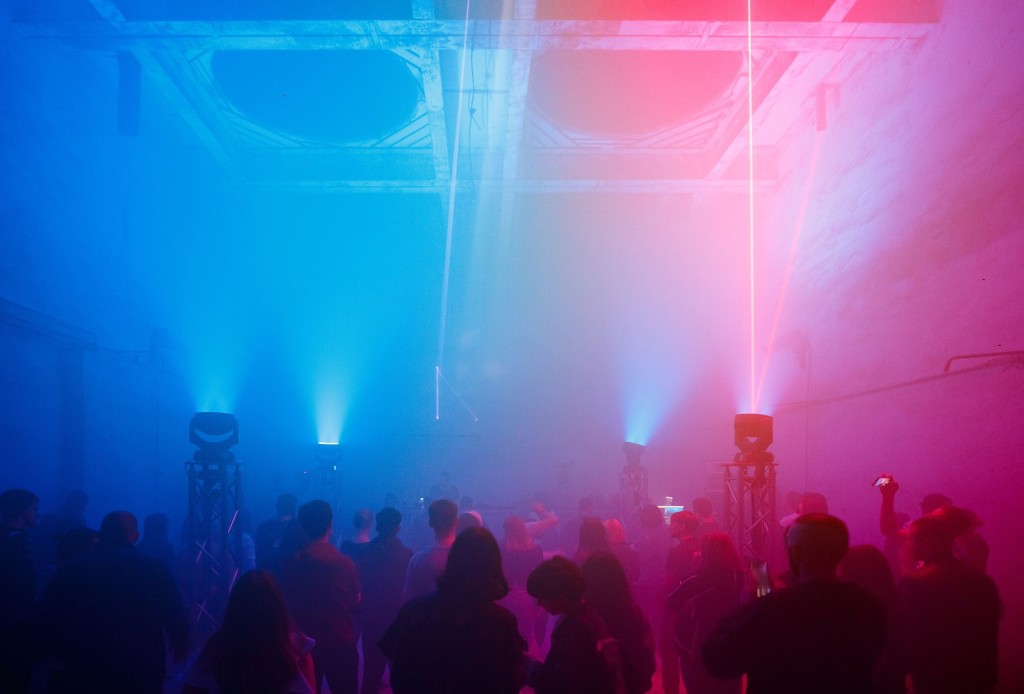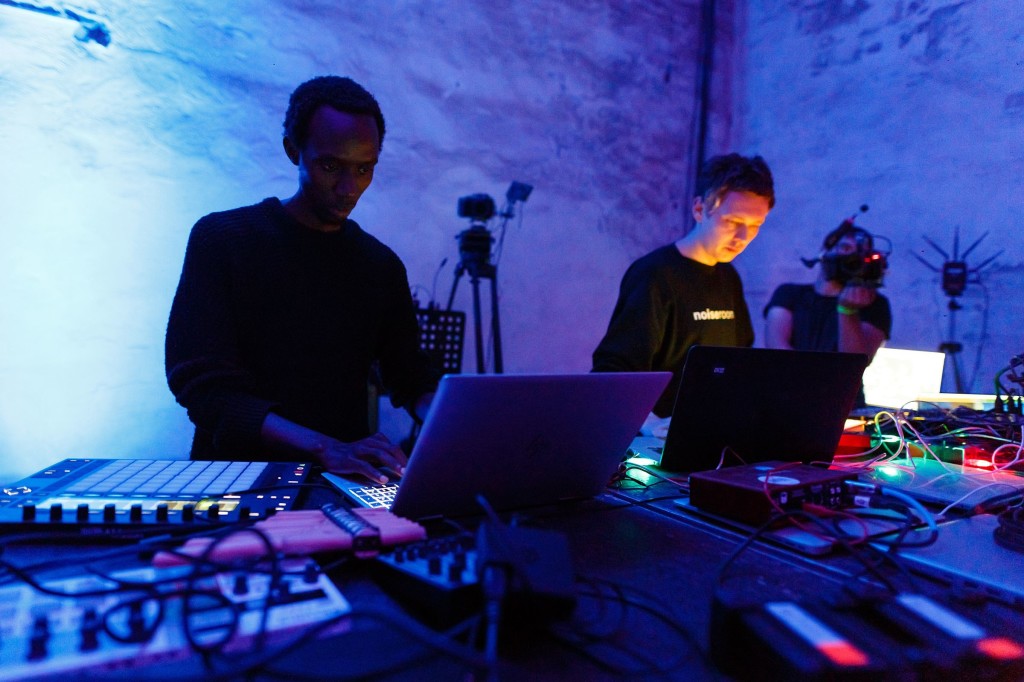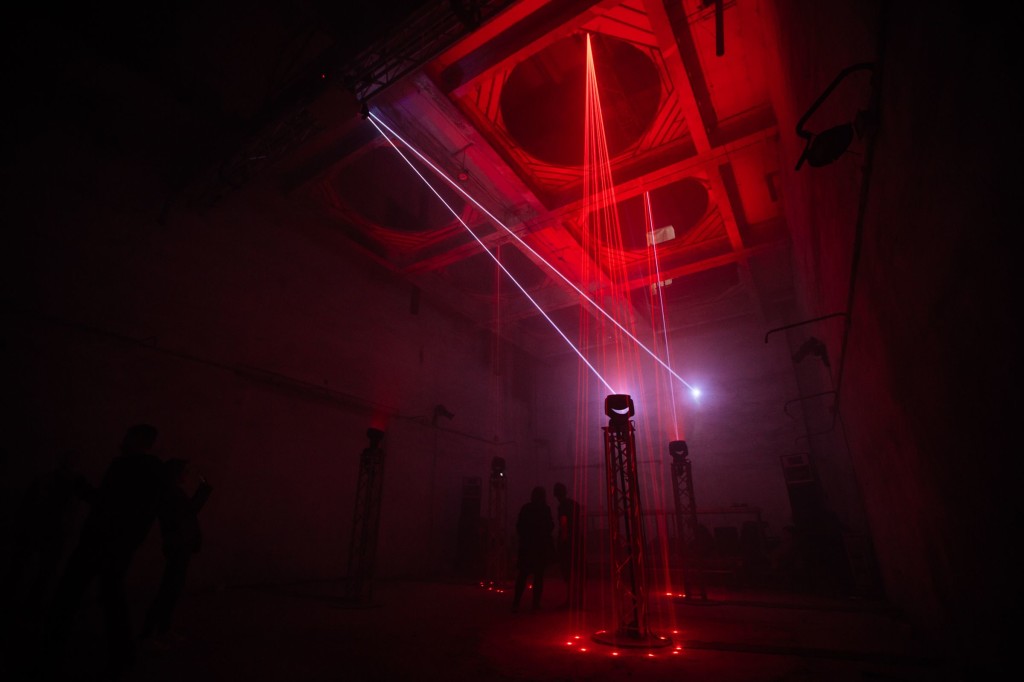What happens when you apply machine learning research to experimental sound – and then play live in front of a festival crowd? Recently, in St. Petersburg, RU, we got to find out.
Our team for Gamma_LAB AI gathered a diverse international team of artists, musicians, musicologists, coders, and researchers, including people who are deep in the field of data science work outside of the arts. (One of our co-hosts was juggling her work in path finding for drones – so not the usual media art approach to AI!) Organizing team (of which I was the only non-Russian member this time):
- Natalia Fuchs, Curator
- Julia Reushenova, Curatorial assistant
- Helena Nikonole, Conceptual artist
- Peter Kirn, Facilitator
- Natalia Soboleva, Facilitator
- Dr. Konstantin Yakovlev, Scientific advisor
… plus our partners, including tech partner Mail.ru Cloud Solutions.
Step one: come together for a 12-day laboratory, bringing us to St. Petersburg in May. That was our chance to learn from one another, take in some lectures, and get started with experiments – everything from digging through how to reconstruct baroque music to generating new sounds for techno and experimental improvisational performance. Participants came from everywhere from Kenya to just around the corner:
Ksenia Guznova (RU), Ilya Selikhov (DE), Anastasia Tolchneva (RU), Michal Mitro (SK), Mar Canet (ESP), Ilia Symphocat (RU), Thomas Disley (USA), Nikita Prudnikov (RU), Tatiana Zobnina (RU), Joseph Kamaru (KE), Egor Zvezdin (RU), Alexander Kiryanko (RU), Katarina Melik-Ovsepian (RU)
Step two – the big leap – come back to St. Petersburg in July, and in a raw industrial space, make the whole thing work for an audience of festival goers. That led to a full program:

- A live media art performance by co-host Helena Nikonole (hacking into Internet of Things devices in real-time from the stage)
- An instrumental group of baroque musicians mixing together historical scores and freshly-generated AI libretto and melodies (led by harpsichordist Katarina Melik-Ovsepyan)
- A mixed acoustic-electronic improv group working with machine learning-produced sounds trained on various experimental sound sources (Ilya Selikhov, Michal Mitro, Symphocat, and KMRU)
- Live-coding duo with an original AI-powered encoder/decoder, built on the artists’ own recordings (Monekeer + Lovozero)
- Yours truly making live techno from generative text, AI-generated loops, and style transfer
And all of this took place in a peak-time, Saturday night festival program, set in an apocalyptic looking ex brewery just before its demolition, complete with immersive, responsive lasers and light by Stanislav Glazov (Licht Pfad studio, Berlin).
Here’s the improv group, working live with their materials:
Plus my own work, produced by training on my own productions and voice; text-to-speech trained on my voice reading text derived from Capek’s R.U.R. Also very nicely shows what Stanislav Glazov was doing with his laser/light immersive install, including responding to the music, all controlled in TouchDesigner:
Some audio examples:
I spoke with curator Natalia Fuchs (ARTYPICAL), who put together the program with us. Natalia is right now presenting the project to MUTEK Festival in Montreal, and has worked not only as a curator and co-producer of GAMMA, but as an advisor to the current AI show at the Barbican Centre.
CDM: First, let’s put the lab in context – there’s Surgeon on one stage, pounding out techno, but then there’s the results of this laboratory, too. What’s the place of GAMMA_LAB inside Gamma Festival?
Natalia: Gamma_LAB is the heart of experimentation at the festival. We launched the LAB in May 2019 – that was a [big reponsibility] for us, because the LAB was self-funded, without any institutional or technological support. Only after the international open-call was announced, we started to get attention from the different partners that [have now] joined the project. By “responsibility” here I mean our relationship with the artists and the audience – we knew that experimental lab is just the first chapter, and the main message will be the conceptual AI stage at the festival.
What does it mean to have a lab inside a festival, to have a place that is making new stuff?
When programming the festival, we always feel like we want to represent local artists and quality local production. And Gamma_LAB is the cultural production unit for us. We focus the project on new artistic and curatorial solutions, on international collaborations – and that means we keep on track, stay connected, and help the community develop.

What has been your relationship to AI as a curator – how would you relate your experience in GAMMA_LAB to your involvement with the Barbican show? CTM Festival? Other projects?
My connection to AI is coming from my general research interests: I am a media art historian and I am deeply concerned by the new media research in relation with AI nowadays. I find it extremely stimulating and exciting – this enormous philosophical quest towards finding the big “other.” So as soon as I started to work closely with Helena Nikonole, conceptual artist of Gamma_LAB, being a peer for her “deus x mchn” project at Rodchenko School in Moscow and advising this artwork to the “Open Codes” exhibition at ZKM Centre for Art and Media in Karlsruhe, I was developing my curatorial approaches to art and AI. Then there were AI-related projects for the Barbican and CTM, but Gamma_LAB for me conceptually throwing my practice back to the Polytech.Science.Art program that I [previously was] curating at the Polytechnic Museum in Moscow. The way we build the processes here including theory, applied studies, performative aspects, it brings same strategy to the next level. In terms of the scale, Gamma_LAB with its connection to the Gamma Festival ([with its] 12000 visitors) has definitely jumped much higher.
Obviously, we know AI is buzzing. But do you feel there’s something unique about this particular set of collaborations – was there a sense that something different happened? In the process itself? In the results?
The engagement of the technical team was very different at the LAB. I think that we found the way to collaborate between disciplines in a way that is interesting for both – technology professionals and media artists. It makes the project very strong, I believe.

There’s lots of curiosity as always about doing projects in Russia. What would you say the relationship of the Russian scene to the international scene is like? I’m certainly grateful for the unique expertise we had; maybe people aren’t so aware of how much technical skill and talent is in our Russian network?
We have had the long period of time when Russian science and technology was subject to control by the government. So internationalization of science is still happening very slowly in Russia. So I don’t think it’s a question of belief, but a question of historical memory. International interest in the technical skill and talent in the Russian network is definitely very strong , but people outside the country know that it was rather impossible to have successful collaboration due to political restrictions. So at the moment, we all have to go through these borders. And Gamma-LAB also supports open communication in the field of science, technology and arts.
The AI workshop began life with the exhibition and the workshop in Berlin – and now you’ve continued on to MUTEK. What’s the longer narrative there? And anything you can talk about as far as where this will go next, or what you hope will happen next with these projects?
The longer narrative is conducting proper artistic research on AI – but with curatorial supervision. Every international festival is interested in the development of cultural production, to expand contemporary culture strategies and be constantly engaged with audience feedback. The more serious collaborative experiences we have, the more profound cultural production is, the more meaningful art experiences can be delivered to the audience. We’re bringing this to the level of collaboration of the festival not only with artistic communities or applied technology makers, but with academic and scientific circles.
My hope is not related to any “next level,” though. I hope it will be the chance to develop a critical approach to AI and the arts. I think there’s no space where people can freely discover and form their own opinions on the AI matters [that compares with] the media art world and festival environments.
Helena, you got to approach joining our team from a different perspective, also haveing worked as a solo media artist. What was your experience?
Helena: The AI Stage… became, from my perspective, one of the most experimental and multi-genre stages at the festival. I showed my piece deus X mchn in the form of performance, which was presented before in a museum in an extremely different environment. Therefore, I thought it was interesting that showing this piece at the festival, I wasn’t planning to serve the expectations of some part of the audience, but then I realized that actually it was the feature of the stage.
All performances, from baroque to noisy improvisation, from digital art to live coding performance could be shown in a museum, as well, and for me, the AI Stage was the best example of how a music festival can become a space for new media art and sophisticated experiments in sound and music. And yes, the audience was just awesome! Of course, some part of it were more used to going to raves than centers for contemporary art, but even these people were genuinely interested in what was happening at the stage, so finally, I was really surprised that sometimes a rave can also educate the audience.


https://gammafestival.ru/ [EN/RU]
Plus John at FACT has an in-depth write-up of the experience, also covering GAMMA_LAB AI Stage and GAMMA_PRO (which I helped moderate):